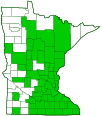Japanese beetle
(Popillia japonica)
Conservation • Description • Habitat • Ecology • Distribution • Taxonomy
|
|
|||||||||||||
Description |
Japanese beetle is an exotic, showy, medium-sized, leaf chafer beetle. It is native to northern Japan. In North America it was first found near Riverton, New Jersey in 1916. Two years later attempts to eradicate it by the USDA failed. It had become established — the population was too large for attempts to control it to be successful. It is now widespread across North America, reported in all of the contiguous 48 states except for Florida. It is well established from Maine to Minnesota south to Arkansas and Georgia. Japanese beetle is a destructive pest in North America where it has no natural enemies. The larvae feed on roots of grass and other plants, causing damage to lawns, parks, golf courses, and pastures. Adults feed on leaves, flowers, and fruits of several hundred species of plants, including fruit trees, ornamental trees, shrubs, vines, field crops, and vegetable crops. They skeletonize leaves by eating the soft tissue but leaving the larger veins. They have caused 50% to 90% defoliation of birch and cottonwood trees in some neighborhoods of the Twin Cities. Adults are ⅜″ to ½″ long and 3 ⁄16″to ¼″ wide. The body is broadly oval, stout, and heavy. Females are slightly larger than males. The first segment of the thorax is large and is covered above by a metallic green exoskeletal plate (pronotum). There are five white tufts of hairs on each side of the abdomen and two white tufts at the tip of the last abdominal segment. The hardened outer forewings (elytra) are iridescent bronze or coppery-brown. They are ridged longitudinally and densely pitted. They do not entirely cover the last segment of the abdomen. There is a small, metallic green, triangular plate (scutellum) between the bases of the wings that is not covered by the elytra. The pronotum, elytra, and scutellum are densely pitted. The head is large and metallic green. It is not concealed beneath the pronotum. The antennae have 9 or 10 segments. When viewed from above the base of the antennae are not visible. The last three segments are expanded sideways on one side into long flattened lobes. The antennal lobes can be closed into a tight club or fanned out to detect odors. The fourth segment (tibia) of the front leg is broadened and toothed, apparently modified for digging. The tibia of the middle leg has two spurs at the tip. The hind legs are closer to the middle legs than to the tip of the abdomen. The end segment of each leg (tarsus) has 5 sections. The last section of the tarsus all legs ends in a pair of claws of unequal length that can be moved independently. On males the tarsus is inserted at the tip of the tibia. The first tarsal section is short and stout. On females the tarsus is inserted toward the middle of the tibia, well below the tip. The first tarsal section longer and more slender. First instar larvae (grubs) are about ⅜″ long, second instar about ¾″ long, and third instar about 1¼″ long. They are white and curled into a C shape. There are three segments of the thorax, each with a pair of legs, and Their bodies are translucent and take on a grayish cast from fecal matter and ingested soil. The anal slit near the end of the abdomen on the underside is crescent-shaped. The spines in front of the anal slit are arranged in a V shape. |
Size |
Total length: ⅜″ to ½″ |
Similar Species |
False Japanese beetle (Strigoderma arbicola) is not iridescent. The head and thorax are dull metallic green. The wings are brown. It does not have tufts of white hair at the sides or tip of the abdomen. |
Habitat |
Anywhere with sufficient foliage |
Ecology |
Season |
Late June to August |
Behavior |
Adults feed on upper leaf surfaces, often in large congregations. They are poor fliers. |
Life Cycle |
The female burrows about 3″ into the soil and lays a few eggs. Between mid-July and early September she will lay 40 to 60 eggs. Several days after being deposited the eggs hatch and the the larvae begin feeding on plant roots. Third-instar larvae overwinter 4″ to 8″ below the soil surface. They pupate in late spring and emerge about two weeks later as adults in late June. Adults first feed on shrubs and other low-lying plants. Later they move to trees to feed and mate. From egg to adult, Japanese beetles live one year. Ten months are spent underground as grubs or pupae, only two months aboveground as adults. |
Larva Food |
Roots of a wide variety of plants |
Adult Food |
Leaves of a wide variety of plants |
Distribution |
||
|
Sources |
|
| 11/9/2024 | ||
Occurrence |
||
Abundant in the seven-county metro, Rochester, and Winona areas. |
||
Taxonomy |
|
Order |
Coleoptera (Beetles) |
Suborder |
Polyphaga (Water, Rove, Scarab, Long-horned, Leaf, and Snout Beetles) |
Infraorder |
Scarabaeiformia |
Superfamily |
Scarabaeoidea (Scarabs, Stag Beetles, and Allies) |
Family |
Scarabaeidae (scarabs) |
Subfamily |
Rutelinae (shining leaf chafers) |
Tribe |
Anomalini |
Subtribe |
Popilliina |
Genus |
Popillia |
Subordinate Taxa |
|
|
|
Synonyms |
|
Popillia plicatipennis |
|
Common Names |
|
Japanese beetle |
|
Glossary
Elytra
The hardened or leathery forewings of beetles used to protect the fragile hindwings, which are used for flying. Singular: elytron.
Pronotum
The exoskeletal plate on the upper side of the first segment of the thorax of an insect.
Scutellum
The exoskeletal plate covering the rearward (posterior) part of the middle segment of the thorax in some insects. In Coleoptera, Hemiptera, and Homoptera, the dorsal, often triangular plate behind the pronotum and between the bases of the front wings. In Diptera, the exoskeletal plate between the abdomen and the thorax.
Tarsus
The last two to five sections of an insect’s leg, attached to the tibia; the foot. Plural: tarsi.
Tibia
The fourth segment of an insect leg, after the femur and before the tarsus (foot). The fifth segment of a spider leg or palp. Plural: tibiae.
Visitor Photos |
||
Share your photo of this insect. |
||
This button not working for you? |
||
Alfredo Colon |
||
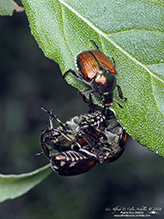 |
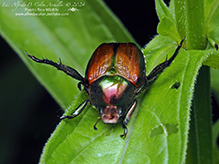 |
|
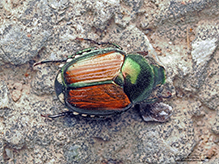 |
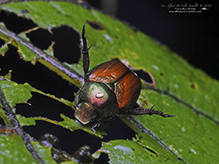 |
|
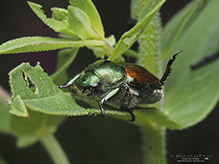 |
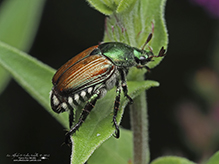 |
|
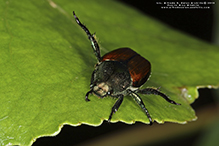 |
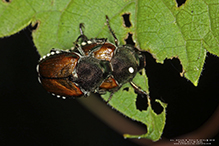 |
|
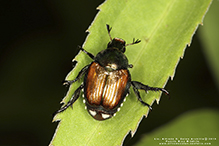 |
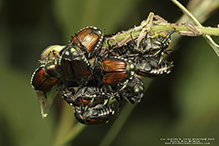 |
|
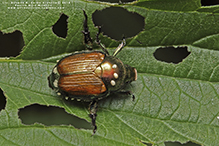 |
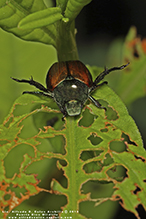 |
|
Mike Poeppe |
||
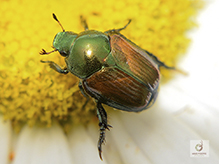 |
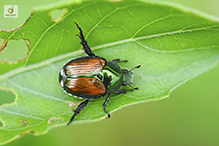 |
|
Nanc |
||
They are already invading my raspberries, beans, pussy willow, borage, basil.......... |
||
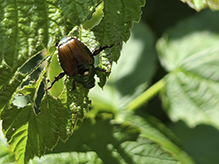 |
 |
|
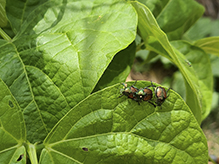 |
||
Lisa Skemp-Thornton |
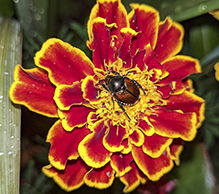 |
Gerry Garcia |
||
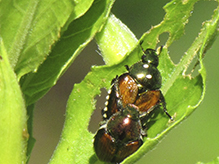 |
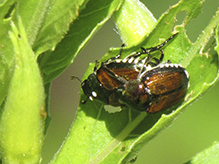 |
|
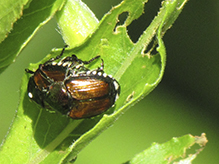 |
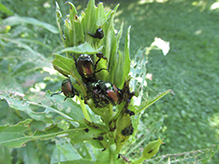 |
|
Margot Avey |
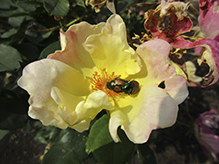 |
MinnesotaSeasons.com Photos |
||
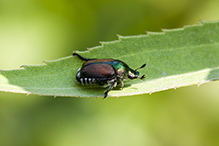 |
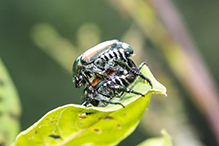 |
|
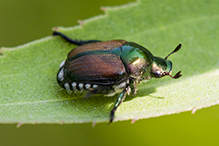 |
||
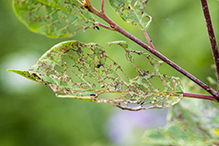 |
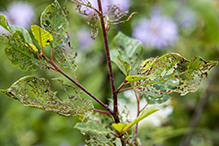 |
|
| Leaf damage of Japanese beetle | Leaf damage of Japanese beetle |

Slideshows |
Japanese Beetle |

|
About
Copyright DianesDigitals |
Japanese beetle (Popillia japonica) |
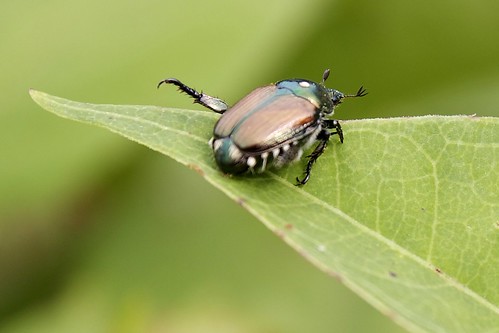
|
Popillia punctata (Japanese Beetle) |
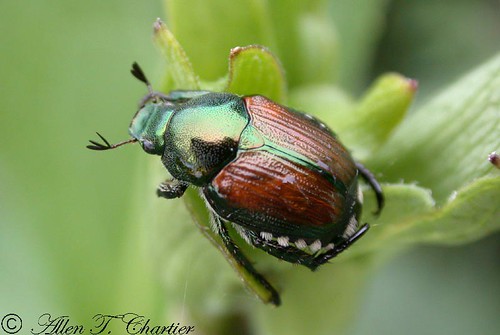
|

Visitor Videos |
||
Share your video of this insect. |
||
This button not working for you? |
||
|
Other Videos |
||
Japanese Beetles (Scarabaeidae: Popillia japonica) Showing Elm Leaf Damage |
About
Uploaded on Aug 6, 2011 Photographed on The Wisconsin side of the Mississippi River north of Red Wing, Minnesota (04 August 2011). |
Japanese Beetle (Scarabaeidae: Popillia japonica) Feeding Close-up |
About
Uploaded on Aug 6, 2011 Photographed on the Wisconsin side of the Mississippi River north of Red Wing, Minnesota (04 August 2011). |
マメコガネ Popillia japonica のペア |
About
Published on Jun 24, 2013 2013年6月24日午後、山口市の山間部で撮影しました。イタドリの葉に多数のペアが集まっていました。 Google Translate: June 24, 2013 afternoon, was shot in the mountainous area of Yamaguchi. A large number of pairs in the leaves of Polygonum cuspidatum had gathered. |
Research on controlling Popillia Japonica |
About
Published on Jun 26, 2015 Researching on Controlling Popillia Japanica |
How to Get Rid of Japanese Beetles |
About
Uploaded on Jul 29, 2010 University of Maine Cooperative Extension discusses what Japanese Beetles are, where you can find them in Maine and what you can do for management of Japanese Beetles. |

Visitor Sightings |
||
Report a sighting of this insect. |
||
This button not working for you? |
||
Alfredo Colon |
Location: Albany, NY |
 |
Alfredo Colon |
Location: Albany, NY |
 |
Alfredo Colon |
Location: Albany, NY |
 |
| Renee 8/5/2023 |
Location: East Gull Lake, Mn found on hanging cigar plant |
|
| Alfredo Colon 8/8/2022 |
Location: Albany, NY |
 |
| Alfredo Colon 8/2/2022 |
Location: Albany, NY |
 |
| Mike Poeppe 7/15/2022 |
Location: Houston County, MN |
 |
| Mike Poeppe 7/11/2021 |
Location: Houston County, MN |
 |
| Nanc 7/8/2021 |
Location: Brooklyn Park, Mn They are already invading my raspberries, beans, pussy willow, borage, basil.......... |
 |
| Lisa Skemp-Thornton 8/2/2020 |
Location: Woodbury, Minnesota I found your website that asked for sightings -- so I'm emailing you. I live in Woodbury, MN and these annoying suckers have been chomping on my marigolds. Any recommendations on how to get rid of them? |
|
| John Valo 8/3/2020 |
You can use traps, poison, or both. Spectracide Bag-a Bug Japanese Beetle Traps are available at Walmart for $4.33 or at any home and garden store. Gardener’s Supply Company has an informative Web page about controling these beetles. Here is the link: |
|
| Alfredo Colon 8/2 - 8/4/2019 |
Location: Woodbury, Minnesota |
| Gerry Garcia 8/4/2019 |
Location: Lyndale Park, Minneapolis, MN |
| Corcoran Athletic Association CAA 6/28/2018 |
Location: Corcoran, MN Hundreds on a small oak and four year old lilac. |
|
| Erica 9/24/2017 |
Location: Rochester, Minnesota 3-4 groups of 6+ beetles congregated on white flowers on a bush on the south side of the electronic sign located at Bethel Lutheran Church at 810 3rd Ave SE. |
|
| Margot Avey 8/31/2017 |
Location: Duluth, MN |
Mjampsa |
Location: Maple Grove, MN |
|
MinnesotaSeasons.com Sightings |
||

Created 3/18/2019 Last Updated: © MinnesotaSeasons.com. All rights reserved. |
